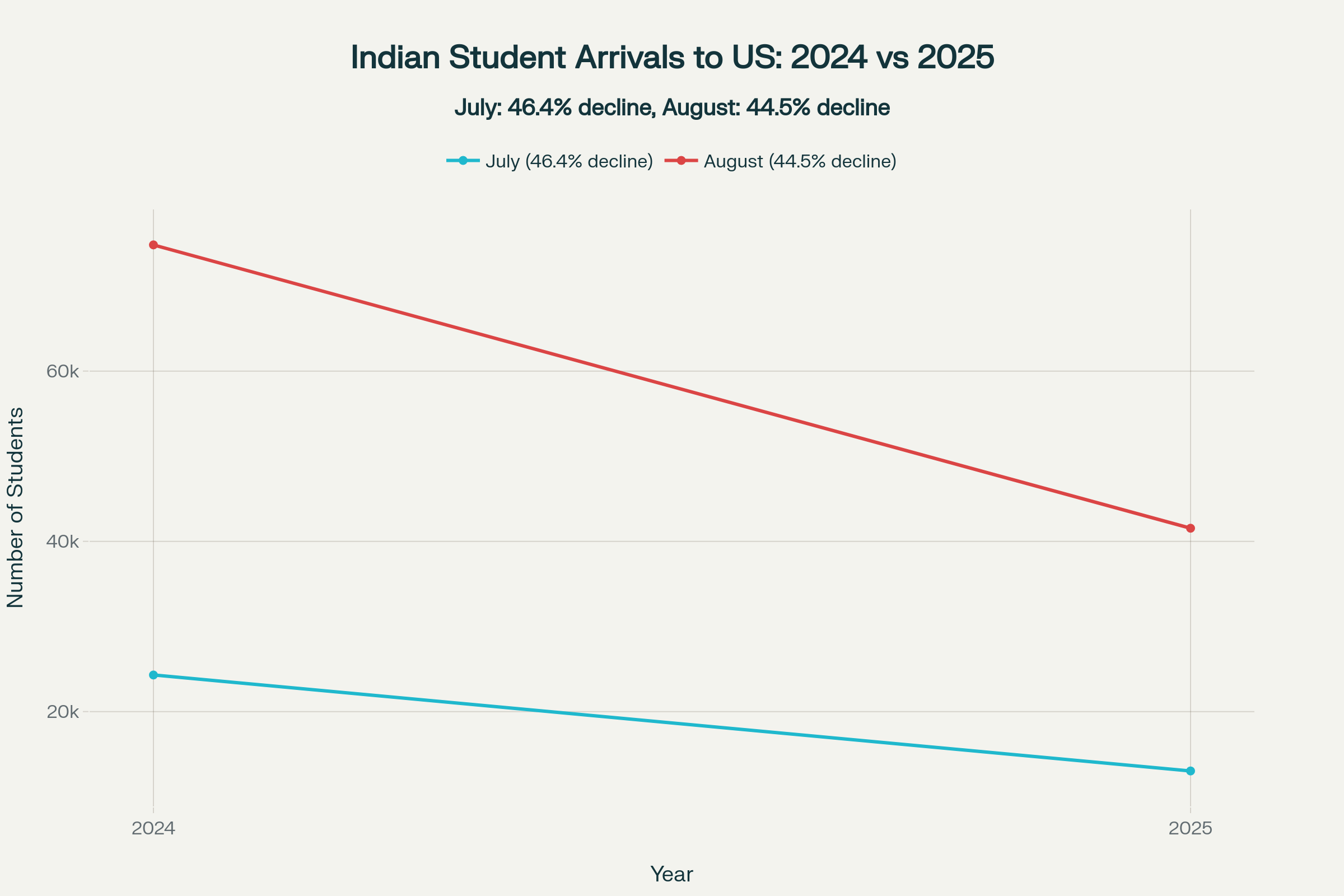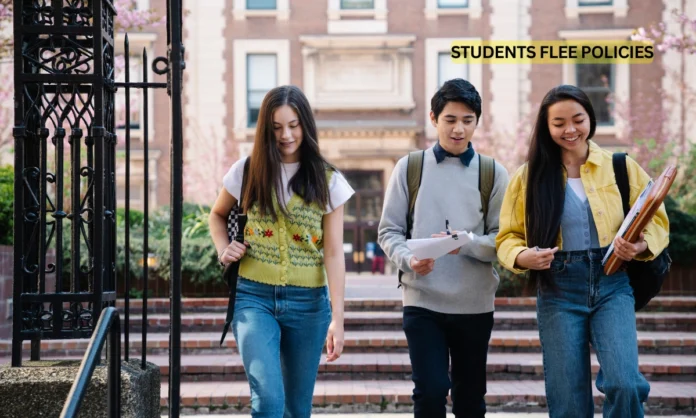Key Highlights:
- Indian student arrivals US universities fell by nearly 50% in July-August 2025 compared to 2024, with 44.5% decline in August and 46.4% drop in July
- Trump administration’s $100,000 H-1B visa fee and stricter immigration policies have created unprecedented uncertainty affecting Indian student arrivals US universities
- Survey data reveals 54% of international students would avoid US universities without Optional Practical Training programs, threatening billions in economic impact
Immigration data from the US International Trade Administration reveals a devastating decline in Indian student arrivals US universities, signaling a potential crisis for American higher education institutions that have increasingly relied on international students for funding and academic excellence. The Trump administration’s restrictive immigration policies, including the controversial $100,000 H-1B visa fee implemented in September 2025, have fundamentally altered the landscape for Indian student arrivals US universities seeking higher education opportunities. This dramatic shift in Indian student arrivals US universities threatens not only individual academic aspirations but also the broader economic ecosystem that international students help sustain across American universities and communities.
Immigration Data Reveals Unprecedented Student Decline
- US International Trade Administration data shows Indian student arrivals US universities dropped from 74,825 in August 2024 to 41,540 in August 2025
- July 2025 witnessed an even steeper decline in Indian student arrivals US universities, falling from 24,298 students in 2024 to just 13,027 in 2025
The Arrival and Departure Information System (ADIS/I-94) immigration records demonstrate the scale of this educational exodus affecting Indian student arrivals US universities, with experts attributing the decline primarily to Trump administration policies that have created substantial barriers for international students. The data encompasses students arriving on F-1 visas during the critical July-August window when most Indian student arrivals US universities occur to begin their fall semester programs. These statistics exclude arrivals from Canada and Mexico, focusing specifically on overseas students who represent the core of Indian student arrivals US universities from international markets.
The Department of Homeland Security’s Student and Exchange Visitor Information System (SEVIS) data corroborates these trends in Indian student arrivals US universities, showing that despite earlier projections of modest growth, recent policy changes have introduced significant risks to international student enrollment. According to the Ministry of External Affairs data presented to the Indian Parliament, 372,424 Indian nationals were pursuing various educational programs in the United States as of June 2025. However, the sharp decline in Indian student arrivals US universities suggests this number will face substantial pressure in the coming academic year.

Sharp decline in Indian student arrivals to the US in July-August 2025 compared to the same period in 2024, showing the impact of Trump administration immigration policies
Trump Administration Policy Changes Create Systemic Barriers
- Presidential proclamation imposes $100,000 supplemental fee on new H-1B visa applications filed after September 21, 2025, directly impacting Indian student arrivals US universities
- Enhanced social media scrutiny and visa interview suspensions have disrupted traditional application processes for Indian student arrivals US universities
- Immigration enforcement actions have terminated over 4,736 SEVIS records since January 2025, affecting primarily Indian and Chinese students
The Trump administration’s September 2025 proclamation restricting entry of certain nonimmigrant workers has fundamentally altered the cost-benefit analysis for Indian student arrivals US universities considering American higher education. The proclamation specifically targets H-1B visa abuse while imposing substantial financial barriers that effectively price out many potential applicants, particularly those from middle-income families seeking Indian student arrivals US universities opportunities. This policy shift represents a dramatic departure from previous approaches that viewed Indian student arrivals US universities as valuable contributors to American economic and academic competitiveness.
Immigration and Customs Enforcement (ICE) has simultaneously intensified enforcement activities affecting Indian student arrivals US universities, with the American Immigration Lawyers Association documenting 327 cases of visa revocations and SEVIS terminations, with 50% affecting Indian students. The enforcement actions have created a climate of fear among international students, with many reporting unexpected termination notices despite compliance with existing regulations. The Trump administration’s “Catch and Revoke” program utilizes AI-assisted reviews to screen social media activity of student visa holders, adding another layer of uncertainty to Indian student arrivals US universities.
Optional Practical Training (OPT) programs face additional scrutiny under new enforcement protocols, with over 69,000 Indian students on OPT potentially facing deportation risks due to stricter unemployment reporting requirements. The uncertainty surrounding OPT continuation has created significant anxiety among current students and deterred prospective Indian student arrivals US universities who view the program as essential for gaining practical experience in their fields of study.
Economic Impact Threatens University Financial Stability
- International students contribute over $7 billion annually to US economy through tuition and living expenses, with Indian student arrivals US universities representing the largest segment
- Projected 30-40% decline in new international enrollment could result in 60,000 fewer jobs and $7 billion in lost revenue from reduced Indian student arrivals US universities
- Indian students accounted for 48% of all STEM OPT participants, representing critical workforce pipeline for American companies
The National Association of Foreign Student Advisers (NAFSA) projects that a 15% overall drop in international enrollment, heavily driven by declining Indian student arrivals US universities, could devastate university finances and local economies that depend on international student spending. American universities have increasingly relied on revenue from Indian student arrivals US universities to subsidize domestic student costs and fund research initiatives, making this enrollment decline particularly threatening to institutional sustainability. The economic multiplier effects extend beyond university campuses to local housing markets, retail establishments, and service industries that cater to Indian student arrivals US universities populations.
Indian students have historically dominated Science, Technology, Engineering, and Mathematics (STEM) programs, with Indian student arrivals US universities accounting for 48% of all overseas enrollments in STEM Optional Practical Training extensions. This concentration in high-demand fields means reduced Indian student arrivals US universities will directly impact American companies’ ability to recruit specialized talent for critical technology and research positions. The Student and Exchange Visitor Program (SEVP) data shows that 1,65,524 foreign students participated in STEM OPT extensions, with Indian student arrivals US universities representing the largest single group contributing to American technological competitiveness.
Universities in states with large international student populations face disproportionate financial pressure from declining Indian student arrivals US universities, with Texas, California, New York, Pennsylvania, and Michigan among the most affected regions. The geographic concentration of impact means certain metropolitan areas and college towns will experience particularly severe economic consequences as Indian student arrivals US universities decline accelerate throughout the 2025-26 academic year.
Survey Data Shows Alternative Destination Preferences
- Institute for Progress and NAFSA survey reveals 54% of international students would not enroll without OPT access, significantly impacting Indian student arrivals US universities
- 53% of graduate students indicated they would not have enrolled if H-1B access was limited by wage level requirements
- Student interest in alternative destinations like Canada, Germany, and Australia has increased as policies affecting Indian student arrivals US universities tighten
Recent survey research demonstrates the critical importance of post-graduation employment opportunities in international student decision-making, with Optional Practical Training serving as a primary motivator for Indian student arrivals US universities over international competitors. The survey findings indicate that immigration policy uncertainty extends beyond immediate visa processing concerns to encompass long-term career planning considerations that influence initial decisions regarding Indian student arrivals US universities. International students increasingly view their educational investment through the lens of probable employment outcomes and immigration pathway availability.
Alternative study destinations have benefited from American policy restrictions affecting Indian student arrivals US universities, with Canada experiencing increased application volumes despite its own recent policy tightening measures. European destinations, particularly Germany and the Netherlands, have positioned themselves as more welcoming alternatives for Indian students seeking STEM education opportunities with clearer pathways to permanent residency. These competitive pressures highlight how immigration policy directly affects American universities’ ability to attract top international talent through Indian student arrivals US universities in an increasingly competitive global education market.
The psychological impact of policy uncertainty extends beyond numerical enrollment statistics to affect the quality and diversity of applicant pools, with many high-achieving Indian students choosing alternative destinations rather than navigate complex and expensive American immigration requirements. This brain drain effect from reduced Indian student arrivals US universities represents a long-term strategic loss for American competitiveness in critical technology and research sectors that have historically benefited from international student contributions.
Final Assessment
The dramatic decline in Indian student arrivals US universities represents more than statistical fluctuation, constituting a fundamental shift in global education patterns that threatens American higher education’s competitive position and economic sustainability. The Trump administration’s immigration policies, while intended to protect American workers, have created unintended consequences that may ultimately harm American economic interests by reducing Indian student arrivals US universities and limiting access to international talent and educational revenue streams. The confluence of increased costs, policy uncertainty, and enforcement risks has created a perfect storm that challenges the traditional appeal of American universities for Indian students arrivals US universities who have historically represented a crucial component of international enrollment.
Universities, policymakers, and industry leaders must grapple with the long-term implications of declining Indian students arrivals US universities, as the current decline in new student arrivals will cascade through graduate programs, research initiatives, and workforce development for years to come. The challenge extends beyond immediate enrollment numbers to encompass broader questions about America’s role in global education and its ability to attract and retain the international talent essential for continued technological and economic leadership.


